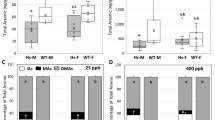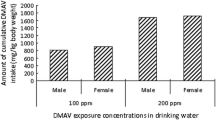Abstract
Arsenic is identified as a known carcinogen and ubiquitously exists in nature. It appears that accumulation of inorganic arsenic (iAs) and its methylated metabolites in various tissues is closely correlated with the long-term toxicity and carcinogenicity of this metalloid. In this study, various arsenic species in murine tissues, especially in the cerebral cortex, cerebellum, and hippocampus, were determined after long-term exposure to 25, 50, 100, and 200 mg/L sodium arsenite in drinking water for 1 and 12 months. Our data showed that the amount of total arsenic (TAs) increased in an obvious dose-dependent manner in various tissues, and TAs levels were in the order of urinary bladder > brain > lung > liver > kidney > spleen. Furthermore, iAsIII and DMA could be observed in all tissues and brain regions with DMA being the predominant metabolite. The bladder, brain, and lung orderly contained the higher levels of DMA, while the liver, kidney, and spleen accumulated the higher proportion of iAsIII. MMA was preferentially accumulated in the lung and bladder of mice regardless of arsenic exposure doses or duration. What’s more, amazingly higher levels of MMA were observed in the hippocampus, which was distinguished from the cerebral cortex and cerebellum. Together with these results, our study clearly demonstrates that the accumulation of iAs and its methylated metabolites is tissue-specific and even not homogeneous among different brain regions in mice by long-term exposure to arsenite. Our study thus provides crucial information for recognizing arsenical neurotoxicity, and reducing the uncertainty in the risk assessment for this toxic metalloid.



Similar content being viewed by others
Abbreviations
- CNS:
-
Central nervous system
- iAs:
-
Inorganic arsenic
- iAsV :
-
Pentavalent inorganic arsenic
- iAsIII :
-
Trivalent inorganic arsenic
- MMAV :
-
Monomethylarsonic acid
- MMAIII :
-
Monomethylarsonous acid
- DMAV :
-
Dimethylarsinic acid
- DMAIII :
-
Dimethylarsinous acid
- MMA:
-
Monomethylated acid
- DMA:
-
Dimethylated acid
- TAs:
-
Total arsenic
- NaAsO2 :
-
Sodium arsenite
- BBB:
-
Blood-brain barrier
- KOH:
-
Potassium hydroxide
- H2SO4 :
-
Ultrapure sulfuric acid
- (NH4)2HPO4 :
-
Diammonium phosphate
- LOD:
-
Limit of detection
- ANOVA:
-
One-way analysis of variation
- LSD:
-
Least significant difference
- AS3MT:
-
Arsenite methyltransferase
References
Cohen SM, Arnold LL, Beck BD, Lewis AS, Eldan M (2013) Evaluation of the carcinogenicity of inorganic arsenic. Crit Rev Toxicol 43(9):711–752. https://doi.org/10.3109/10408444.2013.827152
Marchiset-Ferlay N, Savanovitch C, Sauvant-Rochat MP (2012) What is the best biomarker to assess arsenic exposure via drinking water? Environ Int 39(1):150–171. https://doi.org/10.1016/j.envint.2011.07.015
Smith AH, Lingas EO, Rahman M (2000) Contamination of drinking-water by arsenic in Bangladesh: a public health emergency. Bull World Health Organ 78(9):1093–1103
Vimercati L, Gatti MF, Gagliardi T, Cuccaro F, De Maria L, Caputi A, Quarato M, Baldassarre A (2017) Environmental exposure to arsenic and chromium in an industrial area. Environ Sci Pollut Res Int 24(12):11528–11535. https://doi.org/10.1007/s11356-017-8827-6
Signes-Pastor AJ, Vioque J, Navarrete-Munoz EM, Carey M, Garcia de la Hera M, Sunyer J, Casas M, Riano-Galan I, Tardon A, Llop S, Amoros R, Amiano P, Bilbao JR, Karagas MR, Meharg AA (2017) Concentrations of urinary arsenic species in relation to rice and seafood consumption among children living in Spain. Environ Res 159:69–75. https://doi.org/10.1016/j.envres.2017.07.046
Moon K, Guallar E, Navas-Acien A (2012) Arsenic exposure and cardiovascular disease: an updated systematic review. Curr Atheroscler Rep 14(6):542–555. https://doi.org/10.1007/s11883-012-0280-x
Anwar-Mohamed A, Elshenawy OH, El-Sherbeni AA, Abdelrady M, El-Kadi AO (2014) Acute arsenic treatment alters arachidonic acid and its associated metabolite levels in the brain of C57Bl/6 mice. Can J Physiol Pharmacol 92(8):693–702. https://doi.org/10.1139/cjpp-2014-0136
Xu W, Wang H, Chen G, Li W, Xiang R, Pei Y (2013) (1)H NMR-based metabonomics study on the toxicity alleviation effect of other traditional Chinese medicines in Niuhuang Jiedu tablet to realgar (As2S2). J Ethnopharmacol 148(1):88–98. https://doi.org/10.1016/j.jep.2013.03.073
Vahter M (2002) Mechanisms of arsenic biotransformation. Toxicology 181-182:211–217. https://doi.org/10.1016/s0300-483x(02)00285-8
Hughes MF, Kenyon EM, Edwards BC, Mitchell CT, Razo LM, Thomas DJ (2003) Accumulation and metabolism of arsenic in mice after repeated oral administration of arsenate. Toxicol Appl Pharmacol 191(3):202–210
Kenyon EM, Hughes MF, Adair BM, Highfill JH, Crecelius EA, Clewell HJ, Yager JW (2008) Tissue distribution and urinary excretion of inorganic arsenic and its methylated metabolites in C57BL6 mice following subchronic exposure to arsenate in drinking water. Toxicol Appl Pharmacol 232(3):448–455. https://doi.org/10.1016/j.taap.2008.07.018
Li J, Duan X, Dong D, Zhang Y, Zhao L, Li W, Chen J, Sun G, Li B (2017) Tissue-specific distributions of inorganic arsenic and its methylated metabolites, especially in cerebral cortex, cerebellum and hippocampus of mice after a single oral administration of arsenite. J Trace Elem Med Biol 43:15–22. https://doi.org/10.1016/j.jtemb.2016.10.002
Tyler CR, Allan AM (2013) Adult hippocampal neurogenesis and mRNA expression are altered by perinatal arsenic exposure in mice and restored by brief exposure to enrichment. PLoS One 8(9):e73720. https://doi.org/10.1371/journal.pone.0073720
Vahidnia A, van der Voet GB, de Wolff FA (2007) Arsenic neurotoxicity--a review. Hum Exp Toxicol 26(10):823–832. https://doi.org/10.1177/0960327107084539
Liu S, Piao F, Sun X, Bai L, Peng Y, Zhong Y, Ma N, Sun W (2012) Arsenic-induced inhibition of hippocampal neurogenesis and its reversibility. Neurotoxicology 33(5):1033–1039. https://doi.org/10.1016/j.neuro.2012.04.020
Su CK, Yang CH, Lin CH, Sun YC (2014) In-vivo evaluation of the permeability of the blood-brain barrier to arsenicals, molybdate, and methylmercury by use of online microdialysis-packed minicolumn-inductively coupled plasma mass spectrometry. Anal Bioanal Chem 406(1):239–247. https://doi.org/10.1007/s00216-013-7429-5
Rodriguez VM, Del Razo LM, Limon-Pacheco JH, Giordano M, Sanchez-Pena LC, Uribe-Querol E, Gutierrez-Ospina G, Gonsebatt ME (2005) Glutathione reductase inhibition and methylated arsenic distribution in Cd1 mice brain and liver. Toxicol Sci 84(1):157–166. https://doi.org/10.1093/toxsci/kfi057
Wang Y, Zhao F, Jin Y, Zhong Y, Yu X, Li G, Lv X, Sun G (2011) Effects of exogenous glutathione on arsenic burden and NO metabolism in brain of mice exposed to arsenite through drinking water. Arch Toxicol 85(3):177–184. https://doi.org/10.1007/s00204-010-0573-1
Manthari RK, Tikka C, Ommati MM, Niu R, Sun Z, Wang J, Zhang J, Wang J (2018) Arsenic induces autophagy in developmental mouse cerebral cortex and hippocampus by inhibiting PI3K/Akt/mTOR signaling pathway: involvement of blood-brain barrier's tight junction proteins. Arch Toxicol 92(11):3255–3275. https://doi.org/10.1007/s00204-018-2304-y
Wei S, Zhang H, Tao S (2019) A review of arsenic exposure and lung cancer. Toxicol Res (Camb) 8(3):319–327. https://doi.org/10.1039/c8tx00298c
Currier JM, Douillet C, Drobna Z, Styblo M (2016) Oxidation state specific analysis of arsenic species in tissues of wild-type and arsenic (+3 oxidation state) methyltransferase-knockout mice. J Environ Sci 49:104–112. https://doi.org/10.1016/j.jes.2016.06.018
Healy SM, Casarez EA, Ayala-Fierro F, Aposhian H (1998) Enzymatic methylation of arsenic compounds. V. Arsenite methyltransferase activity in tissues of mice. Toxicol Appl Pharmacol 148(1):65–70
Twaddle NC, Vanlandingham M, Fisher JW, Doerge DR (2018) Metabolism and disposition of arsenic species from controlled dosing with sodium arsenite in adult female CD-1 mice. III. Toxicokinetic studies following oral and intravenous administration. Food Chem Toxicol 121:676–686. https://doi.org/10.1016/j.fct.2018.09.068
Duan X, Gao S, Li J, Wu L, Zhang Y, Li W, Zhao L, Chen J, Yang S, Sun G, Li B (2017) Acute arsenic exposure induces inflammatory responses and CD4(+) T cell subpopulations differentiation in spleen and thymus with the involvement of MAPK, NF-kB, and Nrf2. Mol Immunol 81:160–172. https://doi.org/10.1016/j.molimm.2016.12.005
Zhao L, Yang S, Guo Y, Sun G, Li B (2019) Chronic arsenic exposure in drinking water interferes with the balances of T lymphocyte subpopulations as well as stimulates the functions of dendritic cells in vivo. Int Immunopharmacol 71:115–131. https://doi.org/10.1016/j.intimp.2019.03.022
Kenyon EM, Del Razo LM, Hughes MF (2005) Tissue distribution and urinary excretion of inorganic arsenic and its methylated metabolites in mice following acute oral administration of arsenate. Toxicol Sci 85(1):468–475. https://doi.org/10.1093/toxsci/kfi107
Yamanaka K, Ohtsubo K, Hasegawa A, Hayashi H, Ohji H, Kanisawa M, Okada S (1996) Exposure to dimethylarsinic acid, a main metabolite of inorganic arsenics, strongly promotes tumorigenesis initiated by 4-nitroquinoline 1-oxide in the lungs of mice. Carcinogenesis 17(4):767–770. https://doi.org/10.1093/carcin/17.4.767
Wu X, Guan R, Liu Y, Wu S, Song M, Hang T (2019) Comparative health risk assessment of realgar and NiuHuangJieDu tablets based on tissue arsenic levels after multiple oral administration to rats. J Ethnopharmacol:112370. https://doi.org/10.1016/j.jep.2019.112370
Souza JMO, Grotto D, Batista BL, Barbosa FJ (2017) Distribution of arsenic and oxidative stress in mice after rice ingestion. J Trace Elem Med Biol 44:192–200. https://doi.org/10.1016/j.jtemb.2017.08.007
Waalkes MP, Qu W, Tokar EJ, Kissling GE, Dixon D (2014) Lung tumors in mice induced by “whole-life” inorganic arsenic exposure at human-relevant doses. Arch Toxicol 88(8):1619–1629. https://doi.org/10.1007/s00204-014-1305-8
Cohen SM, Ohnishi T, Arnold LL, Le XC (2007) Arsenic-induced bladder cancer in an animal model. Toxicol Appl Pharmacol 222(3):258–263. https://doi.org/10.1016/j.taap.2006.10.010
Thomas DJ, Li J, Waters SB, Xing W, Adair BM, Drobna Z, Devesa V, Styblo M (2007) Arsenic (+3 oxidation state) methyltransferase and the methylation of arsenicals. Exp Biol Med 232(1):3–13
Twaddle NC, Vanlandingham M, Churchwell MI, Doerge DR (2018) Metabolism and disposition of arsenic species from controlled oral dosing with sodium arsenite in adult female CD-1 mice. I. Pilot study to determine dosing, analytical measurements, and sampling strategies. Food Chem Toxicol 111:482–493. https://doi.org/10.1016/j.fct.2017.12.005
O'Bryant SE, Edwards M, Menon CV, Gong G, Barber R (2011) Long-term low-level arsenic exposure is associated with poorer neuropsychological functioning: a Project FRONTIER study. Int J Environ Res Public Health 8(3):861–874. https://doi.org/10.3390/ijerph8030861
Tyler CR, Allan AM (2014) The effects of arsenic exposure on neurological and cognitive dysfunction in human and rodent studies: a review. Curr Environ Health Rep 1:132–147. https://doi.org/10.1007/s40572-014-0012-1
Juarez-Reyes A, Jimenez-Capdeville ME, Delgado JM, Ortiz-Perez D (2009) Time course of arsenic species in the brain and liver of mice after oral administration of arsenate. Arch Toxicol 83(6):557–563. https://doi.org/10.1007/s00204-008-0378-7
Lu C, Zhao F, Sun D, Zhong Y, Yu X, Li G, Lv X, Sun G, Jin Y (2014) Comparison of speciated arsenic levels in the liver and brain of mice between arsenate and arsenite exposure at the early life. Environ Toxicol 29(7):797–803. https://doi.org/10.1002/tox.21808
Rodriguez VM, Limon-Pacheco JH, Del Razo LM, Giordano M (2016) Effects of inorganic arsenic exposure on glucose transporters and insulin receptor in the hippocampus of C57BL/6 male mice. Neurotoxicol Teratol 54:68–77. https://doi.org/10.1016/j.ntt.2016.02.001
Grau-Perez M, Kuo CC, Gribble MO, Balakrishnan P, Jones Spratlen M, Vaidya D, Francesconi KA, Goessler W, Guallar E, Silbergeld EK, Umans JG, Best LG, Lee ET, Howard BV, Cole SA, Navas-Acien A (2017) Association of low-moderate arsenic exposure and arsenic metabolism with incident diabetes and insulin resistance in the strong heart family study. Environ Health Perspect 125(12):127004. https://doi.org/10.1289/EHP2566
Kuo CC, Moon KA, Wang SL, Silbergeld E, Navas-Acien A (2017) The association of arsenic metabolism with cancer, cardiovascular disease, and diabetes: a systematic review of the epidemiological evidence. Environ Health Perspect 125(8):087001. https://doi.org/10.1289/EHP577
Sanchez-Pena LC, Petrosyan P, Morales M, Gonzalez NB, Gutierrez-Ospina G, Del Razo LM, Gonsebatt ME (2010) Arsenic species, AS3MT amount, and AS3MT gene expression in different brain regions of mouse exposed to arsenite. Environ Res 110(5):428–434. https://doi.org/10.1016/j.envres.2010.01.007
Adriana Sampayo-Reyes RAZ, Healy SM, Aposhian HV (2000) Monomethylarsonic acid reductase and monomethylarsonous acid in hamster tissue. Toxicol 13:1181–1186
Funding
This study was supported by grants from National Natural Science Foundation of China (NSFC) (No. 81673114), Applied and Basic Research Program from Tangshan Science and Technology Bureau (18130205a), and Youth Science and Technology Project from Health Commission of Hebei Province (20191096).
Author information
Authors and Affiliations
Corresponding author
Ethics declarations
All trials were approved by the Animal Care and Use Committee of China Medical University.
Conflict of Interest
The authors declare that they have no conflict of interest.
Additional information
Publisher’s Note
Springer Nature remains neutral with regard to jurisdictional claims in published maps and institutional affiliations.
Rights and permissions
About this article
Cite this article
Li, J., Guo, Y., Duan, X. et al. Tissue- and Region-Specific Accumulation of Arsenic Species, Especially in the Brain of Mice, After Long-term Arsenite Exposure in Drinking Water. Biol Trace Elem Res 198, 168–176 (2020). https://doi.org/10.1007/s12011-020-02033-x
Received:
Accepted:
Published:
Issue Date:
DOI: https://doi.org/10.1007/s12011-020-02033-x




